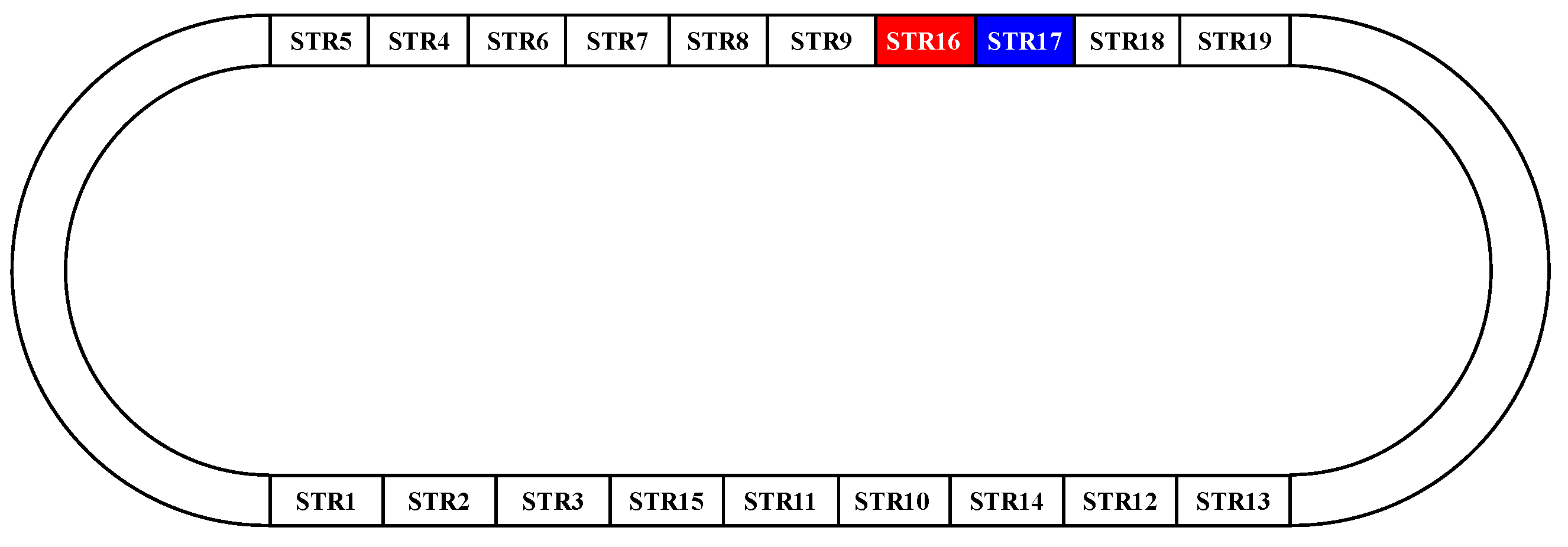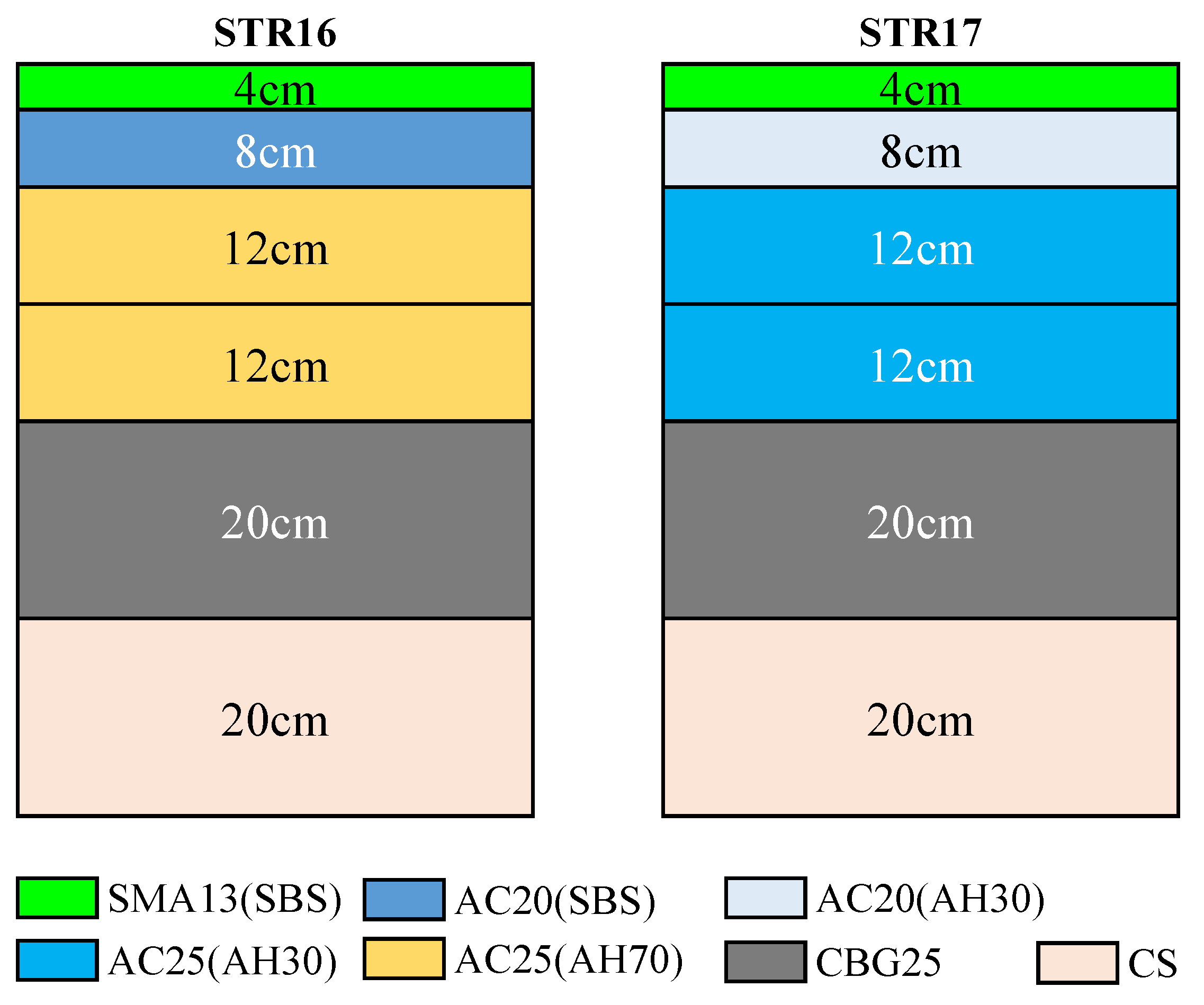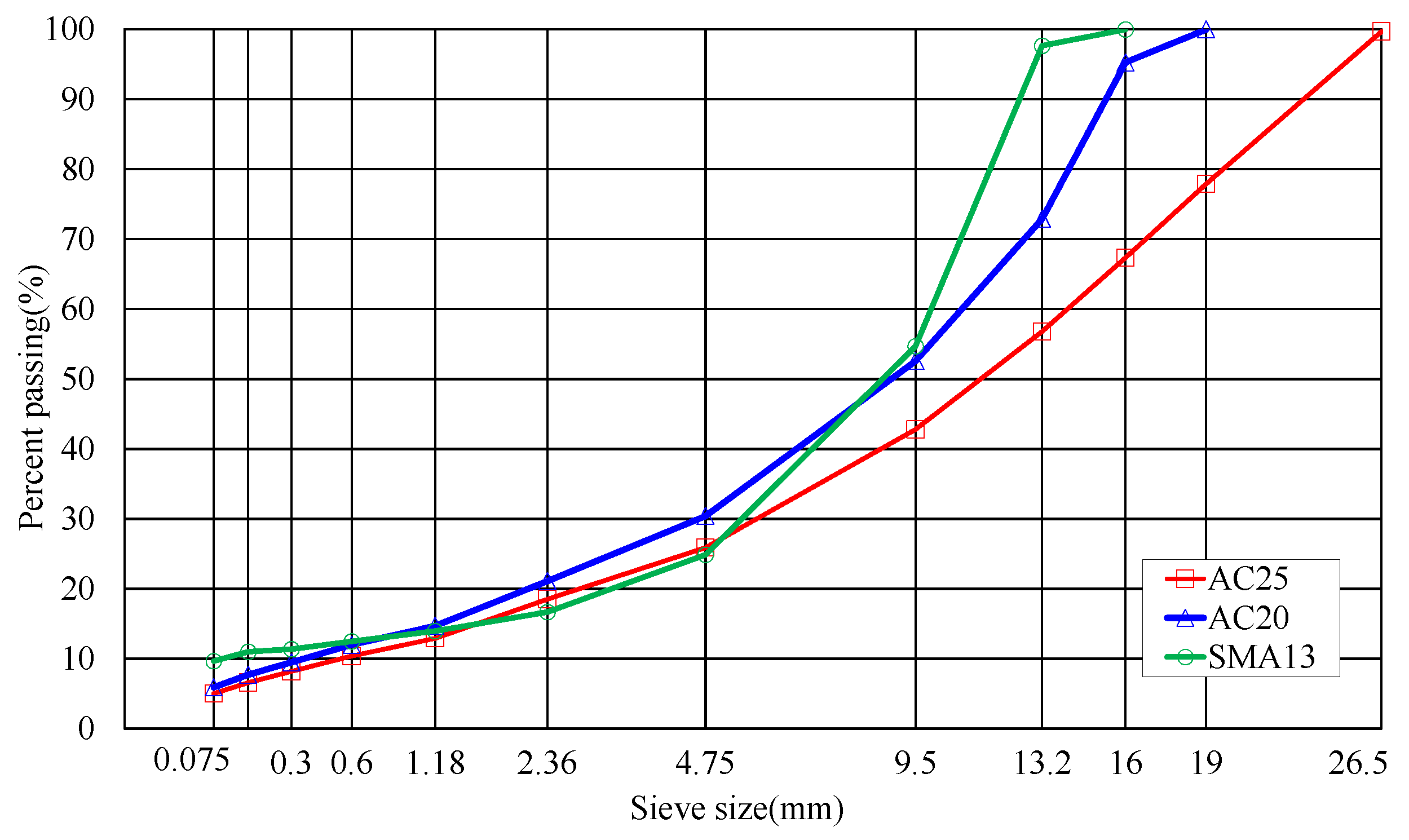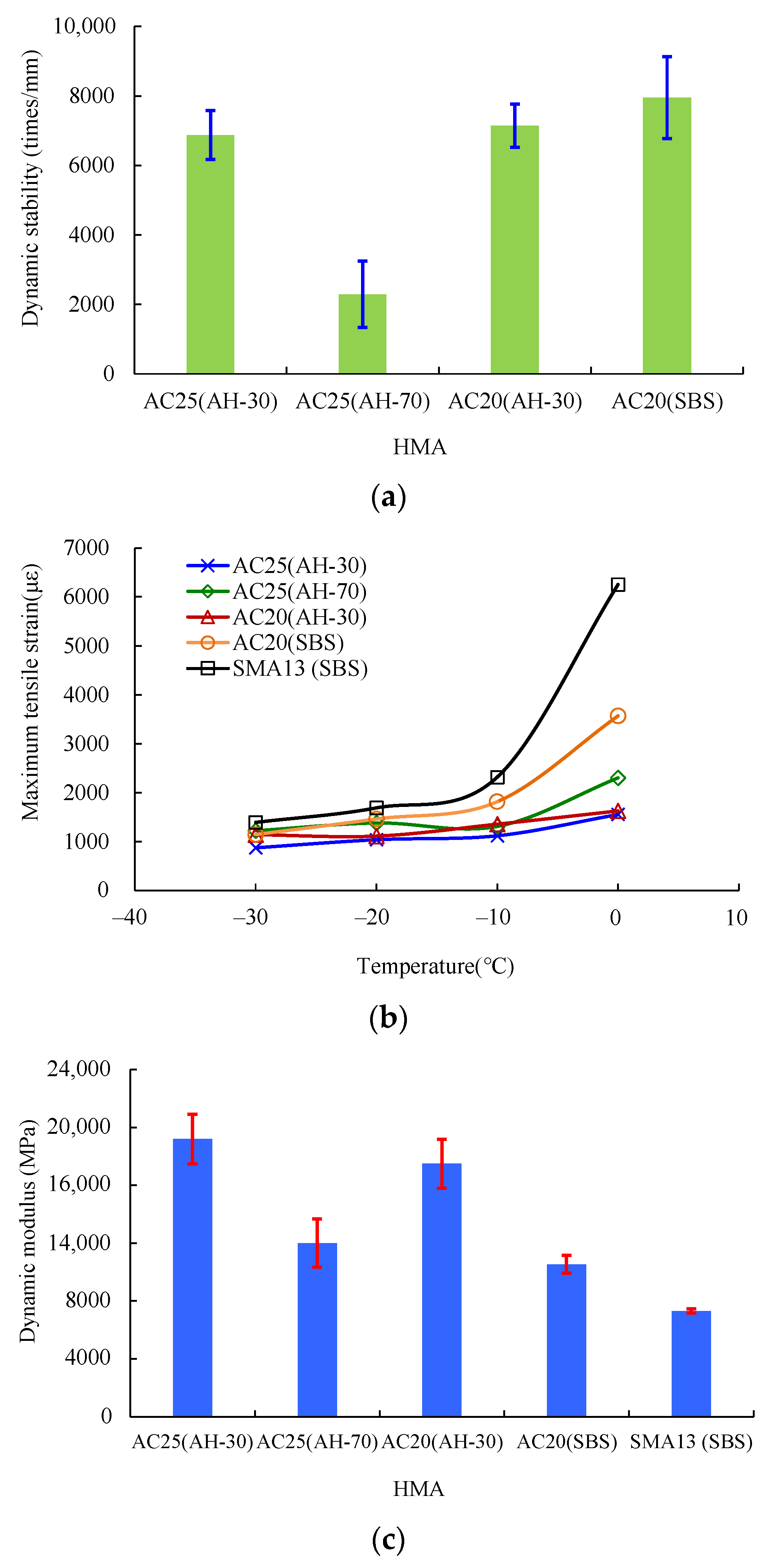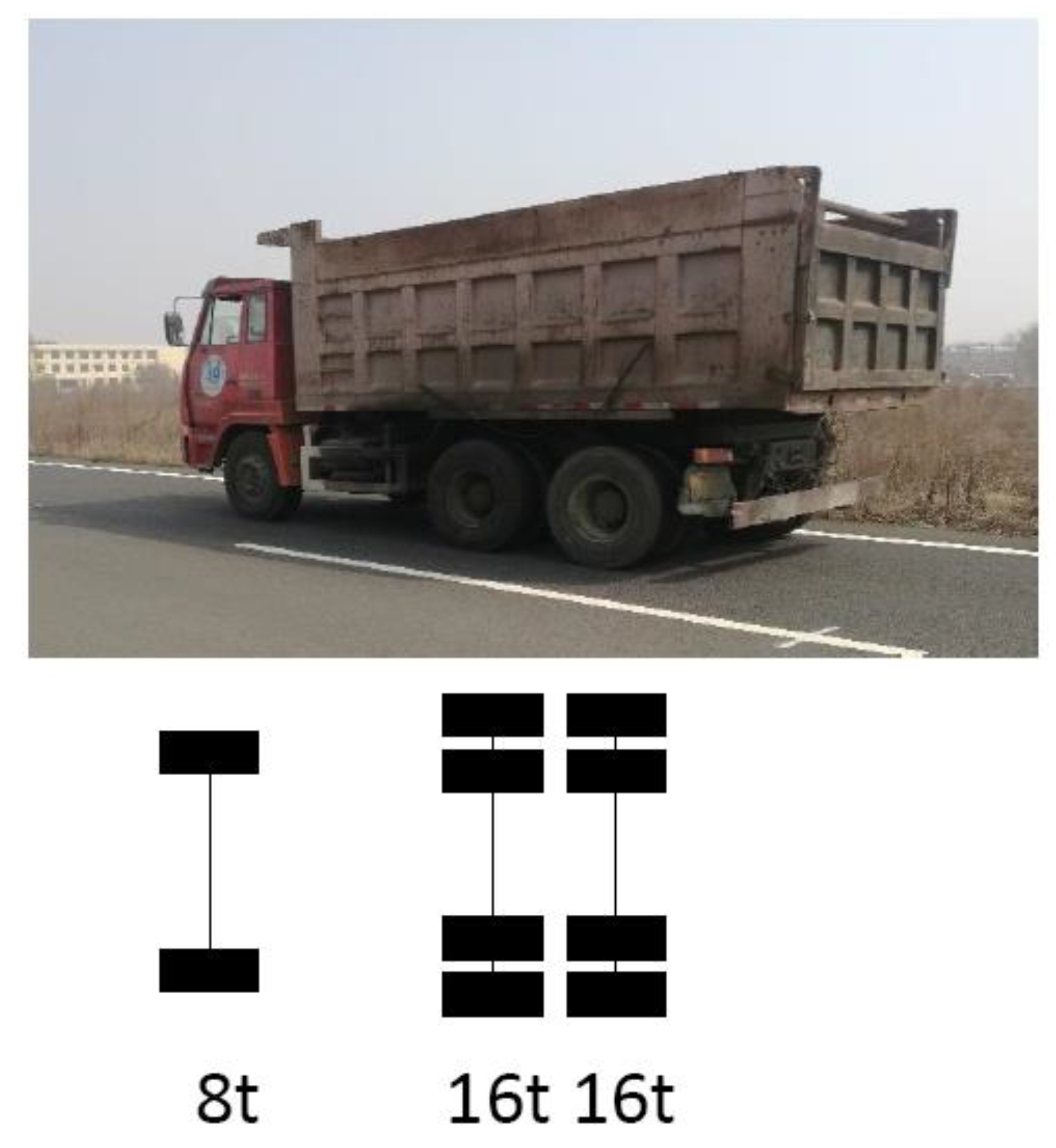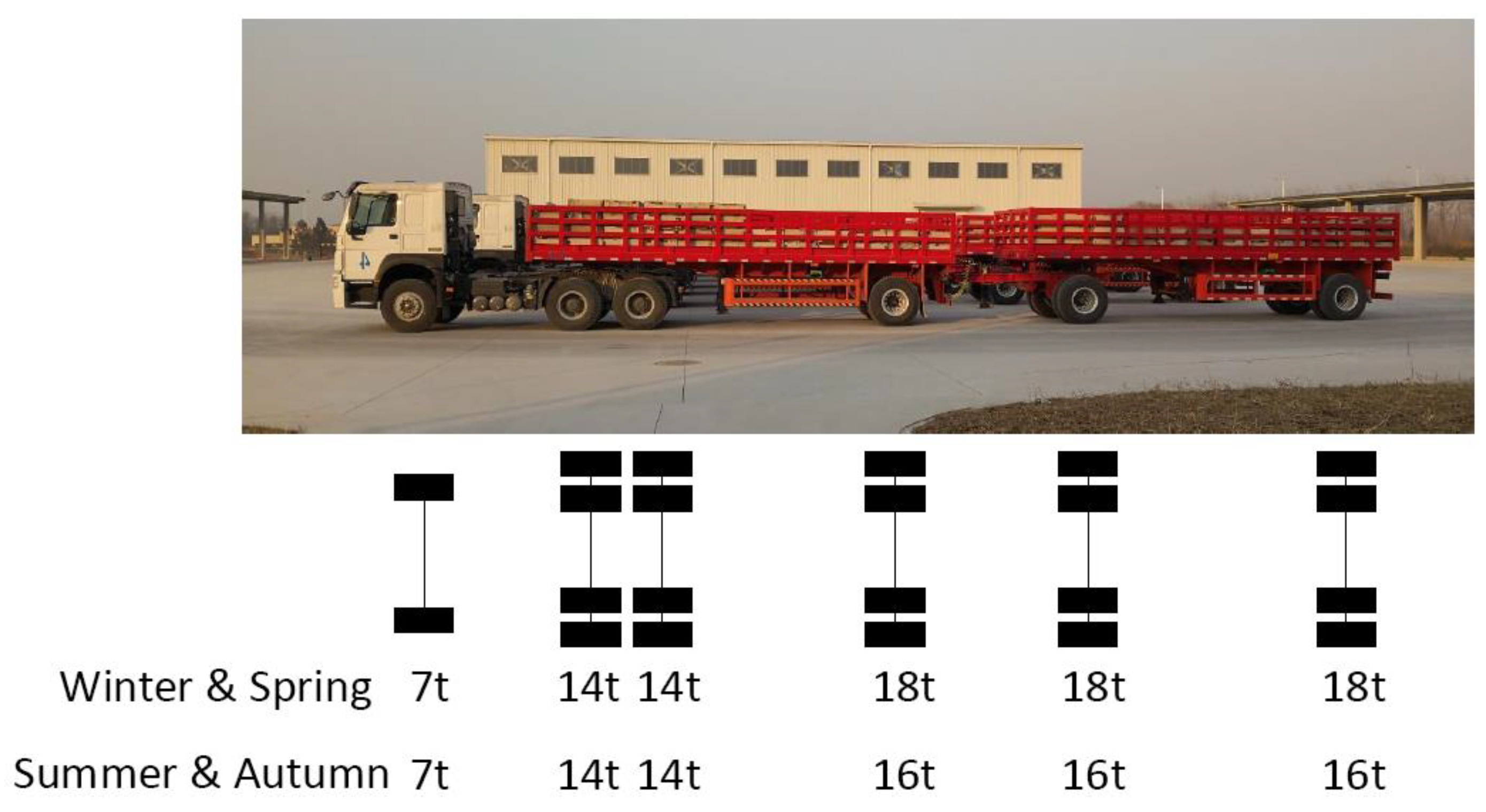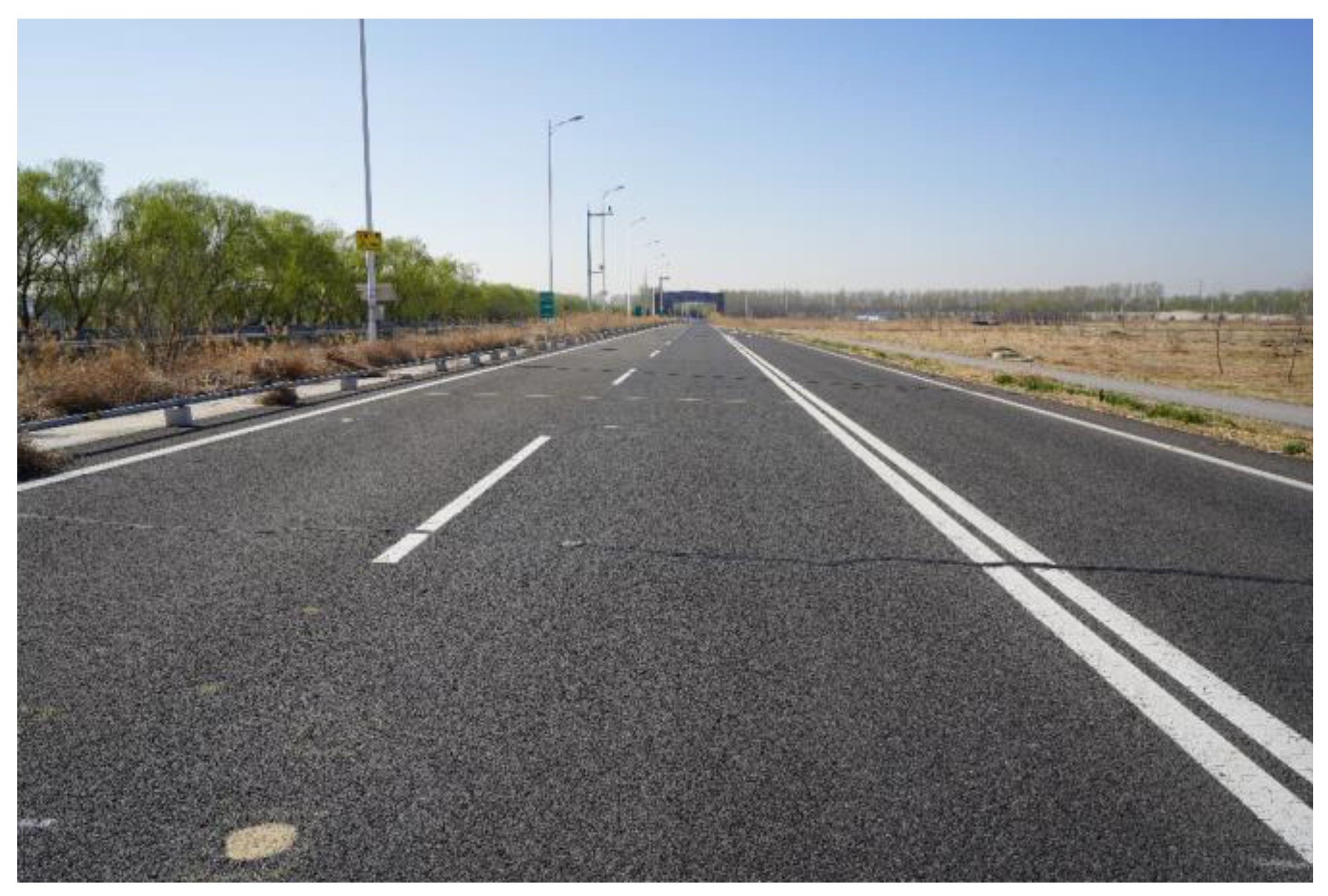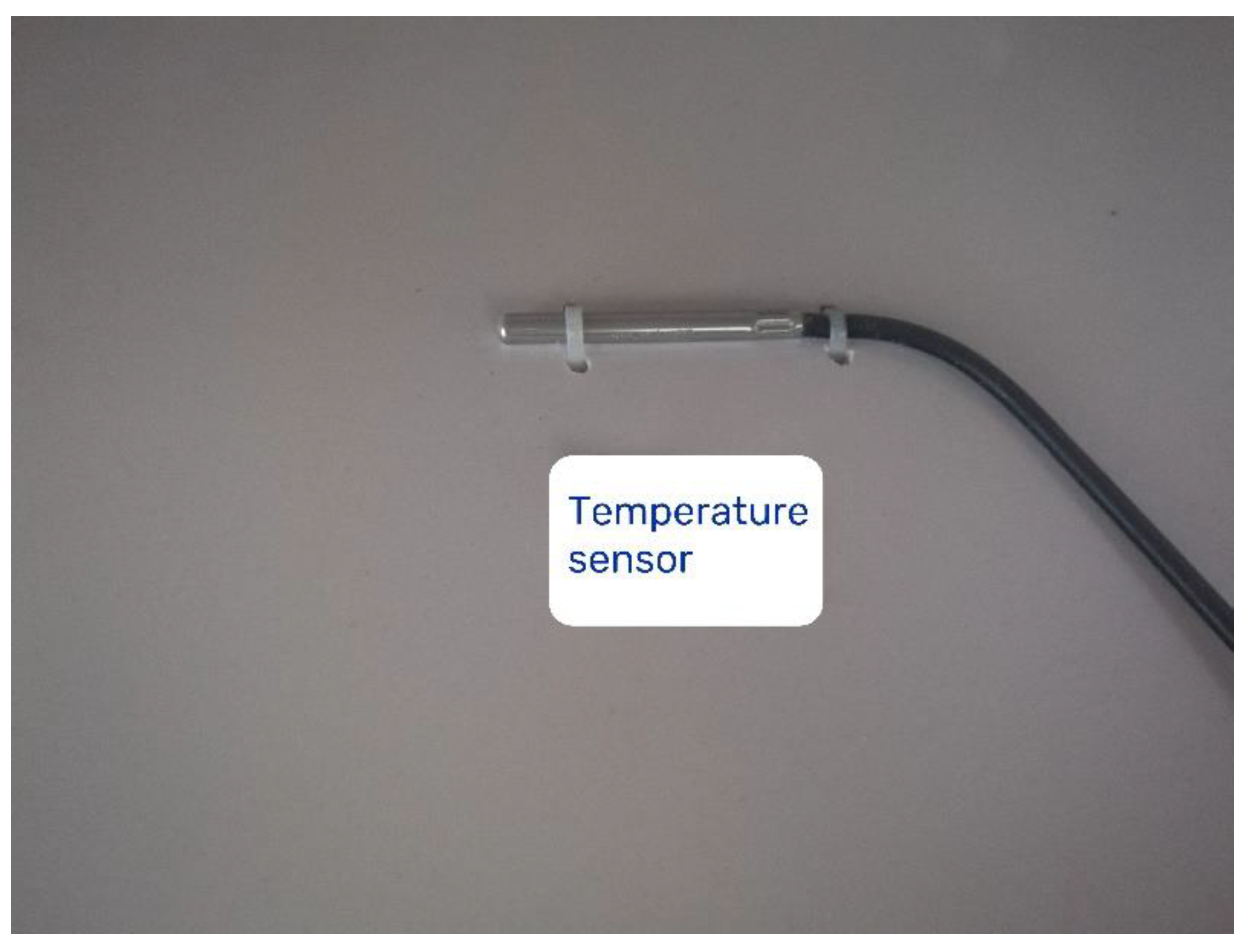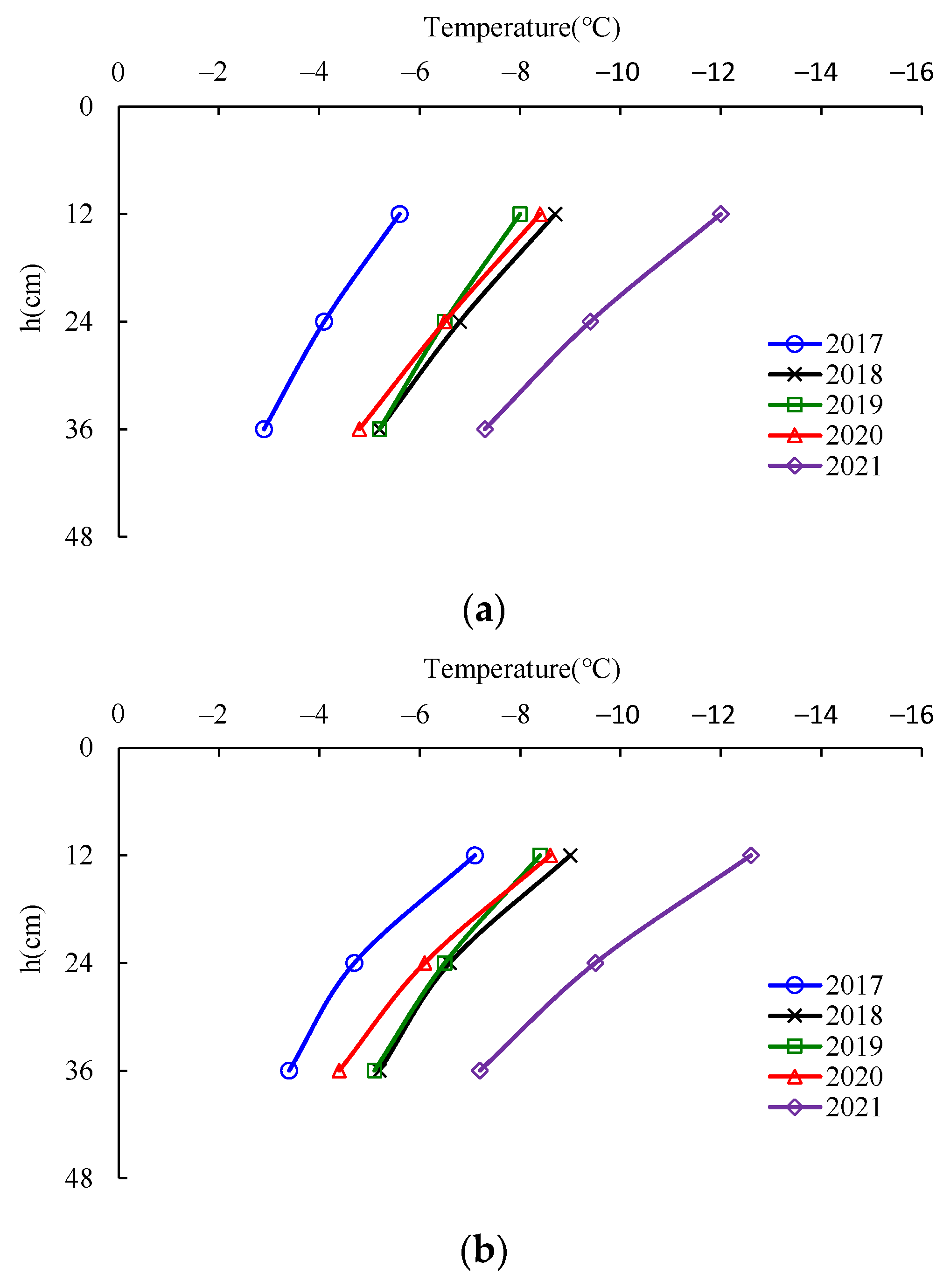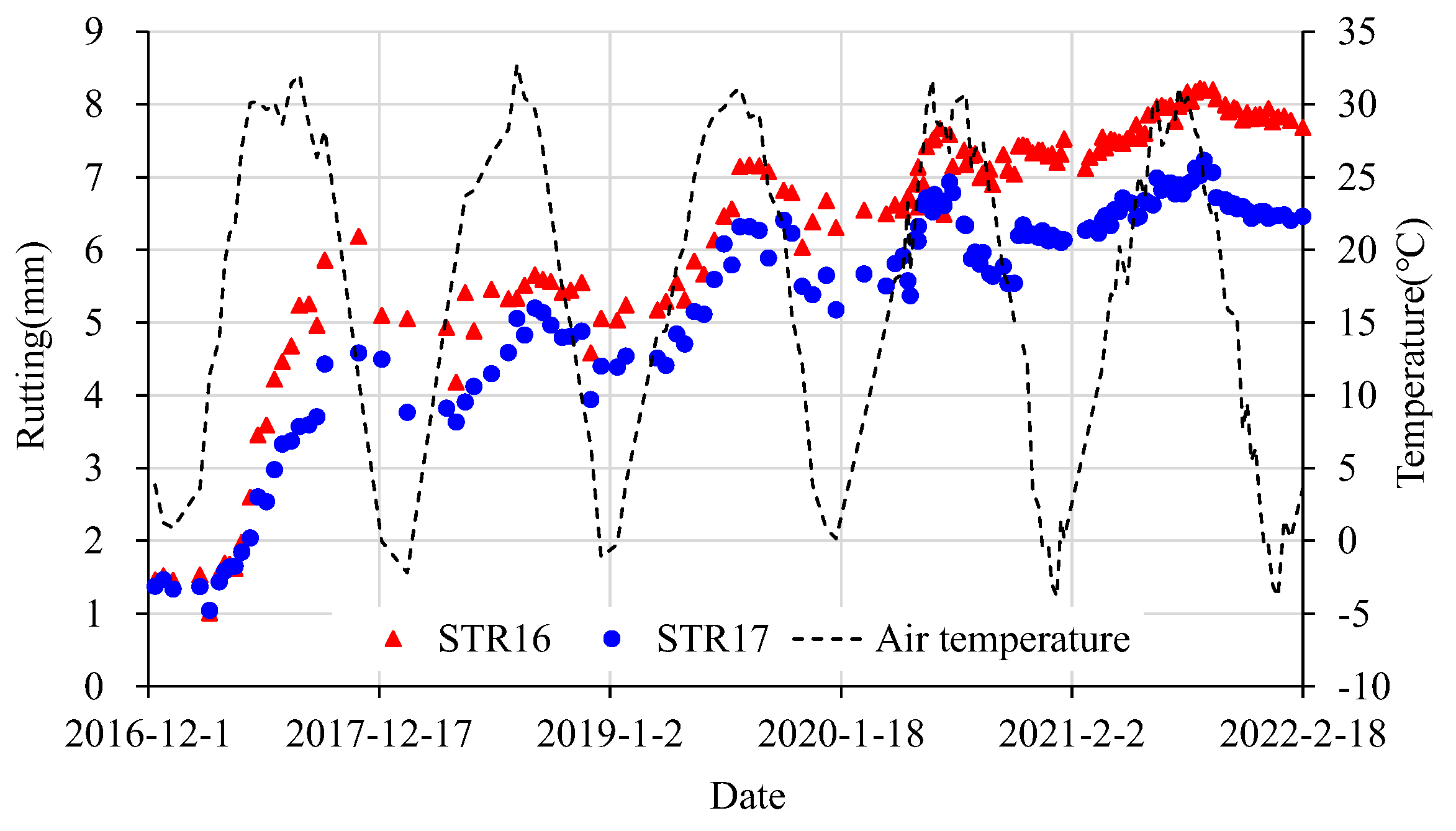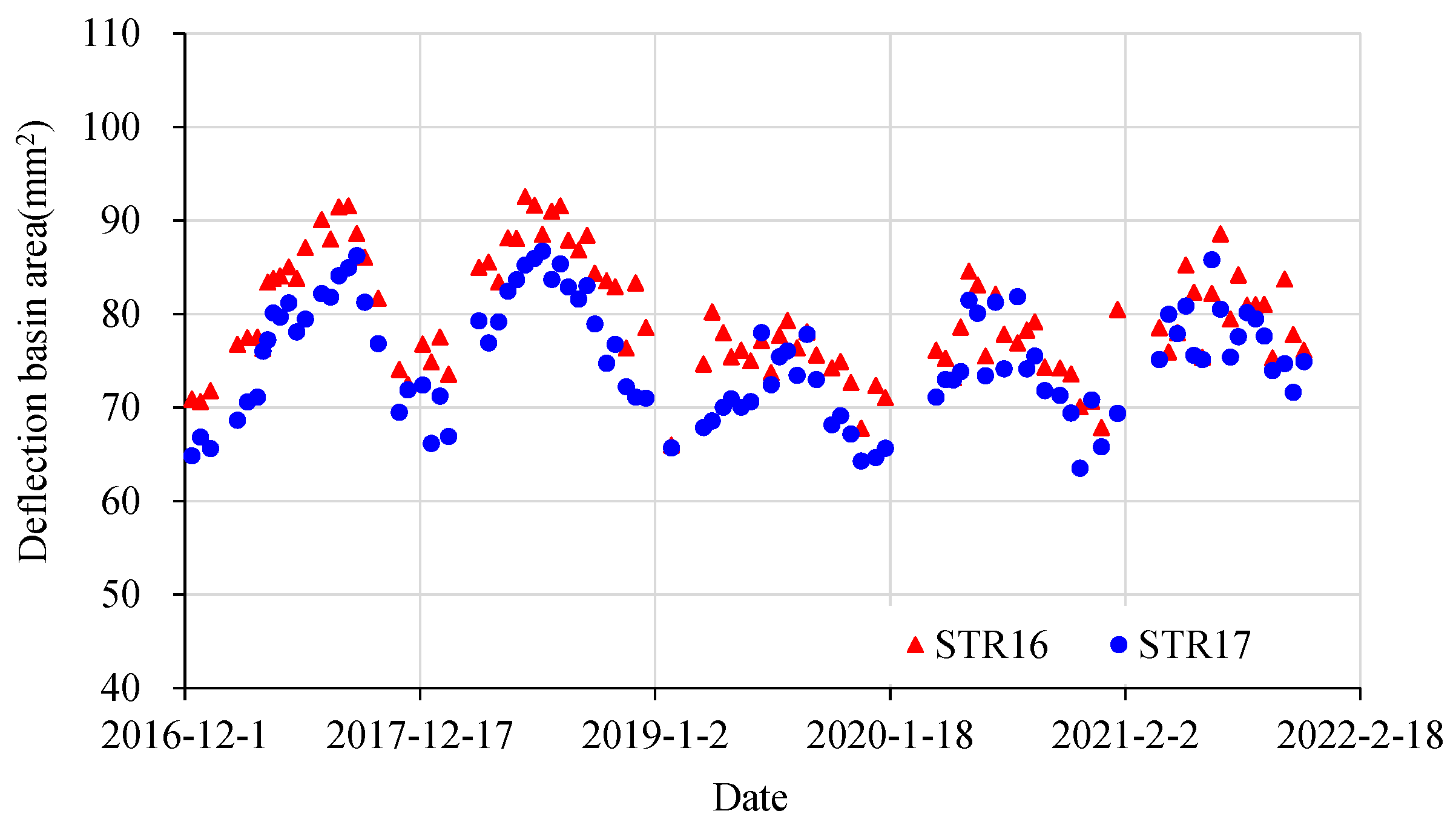1. Introduction
Asphalt with low penetration is suitable for the production of high-modulus asphalt concrete [
1] due to its high hardness and viscosity, and is often used as the base for new asphalt pavements or as a structural reinforcement layer in maintenance and renovation projects. The penetration grade (PG) of this asphalt at 25 °C is generally 10 to 40. It is also called hard-grade asphalt. Hard asphalt with a PG of 10/20 or 15/25 is mostly used in Europe [
2,
3]. The most widely used in China is road petroleum asphalt, with a PG of 20/40 [
4].
Hard-grade asphalt and mixtures have been studied previously in Europe, and are more widely used. High-modulus asphalt concrete prepared with hard-grade asphalt first appeared in France in the 1980s [
5,
6]. In order to reinforce the heavy traffic asphalt pavement structure, asphalt with a PG of 15 is used as the base or lower surface layer in an asphalt mixture, and the amount of asphalt is increased to the same level as the surface layer, which significantly improves its resistance to permanent deformation. The fatigue life can be extended by 30%. After this success, France has formulated corresponding technical specifications [
7,
8], which has made hard-grade asphalt widely popular in French road construction. Currently, 50% of the French asphalt pavement base and lower surface layers are applied with high-modulus asphalt concrete [
3]. Due to the good road performance of hard-grade asphalt and mixtures, they have attracted the attention of many countries in the world. In Switzerland [
3,
9], Spain [
3,
10], the United Kingdom [
11], Portugal [
12], Belgium [
3], South Africa, Australia [
13], the United States [
14], Canada [
3], China [
15], etc., corresponding research and applications have also been carried out, which have greatly promoted the development of this technology.
Recently, researchers have carried out a lot of research work on the preparation of hard-grade asphalt binder. Lee [
16] mixed base asphalt with high-boiling point petroleum and 4% styrene-butadiene rubber to prepare hard-grade asphalt, which not only improved the asphalt stiffness, but also ensured its ductility. Peng [
17] prepared hard-grade asphalt based on crude oil and vacuum residue through propane deasphalting, deep distillation, mild oxidation and additive modification. The road performance and mechanical properties of the prepared asphalt mixture were better than those of an SBS-modified asphalt mixture, and Meng [
18] also came to the same conclusion. Yang [
19] mixed the base asphalt with buton rock asphalt to prepare hard-grade asphalt, and the prepared asphalt mixture showed good durability and fatigue performance.
For hard-grade asphalt mixtures, there are many corresponding studies and applications, mainly focusing on road performance research in the laboratories, and long-term performance evaluation based on outdoor field tests. Amjad et al. [
20] studied the properties of hard asphalt and high-modulus asphalt mixtures. Compared with conventional asphalt mixtures, the fatigue damage resistance was increased by 9.3%, and the resilience modulus at 60 °C was increased by 63%. Espersson et al. [
21] conducted a study on the effect of temperature on high-modulus asphalt mixtures, and the results show that a high modulus could still be maintained at high temperatures. When used as the base of airport pavement, it can not only reduce the thickness of the pavement, but it also improves the fatigue performance. Yang et al. [
22] applied a dissipative energy method to evaluate the fatigue properties of high-modulus asphalt mixtures. Capitao et al. [
23] and Perret et al. [
24] found, through full-scale tests and long-term observations on test roads, that the high-temperature performance of high-modulus asphalt mixtures is significantly better than that of conventional pavement materials. The accelerated loading test carried out by Montanelli [
25] showed that the rutting depth of hard-grade asphalt concrete is basically the same as that of SMA, and is obviously better than that of ordinary asphalt concrete. DeBacker [
17] and Lee et al. [
16] also came to similar conclusions via field tests. Liu et al. [
26] found that the rutting depth of hard-grade asphalt concrete pavements is about one-third of that of ordinary asphalt pavements. Bankowski et al. [
27] conducted a long-term performance comparison test using HVS, and the results show that the fatigue life of hard-grade asphalt concrete pavement is much higher than that of ordinary asphalt pavement. Diefenderfer et al. [
28] paved a hard-grade asphalt pavement test road at three locations, and the results show that its resistance to wheel-induced damage was significantly better than that of a conventional asphalt pavement. Guo et al. [
29] measured the dynamic response of the pavement structure using on-site embedded sensors. The results show that the lateral and longitudinal strains at the bottom of the asphalt layer of the high-modulus asphalt pavement structure were smaller than in other asphalt pavement structures. High-modulus asphalt mixtures can significantly improve pavement structural performance.
In China, the research and application of hard-grade asphalt and mixtures started relatively late, and currently, it mainly focuses on the laboratory test research of asphalt materials and asphalt mixtures [
30,
31]. In actual projects, Hebei, Guangdong, Guangxi, Inner Mongolia and other provinces and cities have only constructed some test sections with short lengths, and have not yet carried out large-scale engineering application [
32,
33]. There are two main reasons for this. On the one hand, hard-grade asphalt concrete has good road performance, while the long-term service performance verification of practical engineering in China has not been carried out, and the reliability and applicability of this technology are still doubtful. On the other hand, hard-grade asphalt concrete has been widely studied and applied in Europe, while the asphalt pavement structure in China generally uses semi-rigid subbase or base. China’s natural environment, road construction materials, pavement design methods, etc., are quite different from those in European countries, so the mature practices of European countries cannot be directly applied in China.
Therefore, in order to evaluate whether hard-grade asphalt concrete is suitable for use in highway construction in China, this study relies on the accelerated loading test of full-scale pavement to obtain service performance data of the whole life cycle. The long-term service performance of hard-grade asphalt concrete base pavement is studied to evaluate its actual service effect, and to provide a certain reference and guidance for its promotion and application in China.
The main purpose of this study is to examine the long-term service performance of hard-grade asphalt concrete base pavement, to determine whether this material is suitable for use in road construction in China. A test has been conducted on a full-scale test track of the Research Institute of Highway Ministry of Transport (RIOHTrack). The hard-grade asphalt concrete base pavement structure was placed in the straight-line section of the track. During the test, heavy trucks were used for accelerated loading. Given that the pavement structure simulated by this test track has been in service for long enough, the long-term service performance of the hard-grade asphalt concrete base pavement can be studied based on indicators of the pavement structure, such as cracking, rutting, and deflection obtained in the accelerated loading test, and thereby its performance in practical use can be evaluated.
2. Materials and Methods
2.1. RIOHTrack Full-Scale Road Test Track
RIOHTrack, which this study relies on, is the first full-scale road test track in China’s road engineering field. It is located in Beijing, where the average temperatures in the coldest month and in the hottest month are −4.6 °C and 25.8 °C, respectively. RIOHTrack is an oval closed curve composed of a straight line and a circular curve, laid out in a north–south direction and arranged symmetrically. The total length of the route is 2.039 km. According to the linear characteristics of the test road and the purpose of the test, it is divided into two test sections: the straight line section and the curve section. There are 19 pavement structures in the straight section, and the layout is shown in
Figure 1. Various pavement structures paved by the RIOHTrack are very representative in China, basically covering more than 90% of the commonly used pavement structure types on the asphalt pavement of China’s expressways. Moreover, each test section of the RIOHTrack was constructed with the same structure thickness, pavement material, and construction technology as the actual project. The width of each test section is 7.5 m, and two inner and outer lanes are set; each lane is 3.75 m wide, and the acceleration loading of the real vehicle is mainly aimed at the inner lane. The section length is 50–60 m, and the test size is also completely consistent with the actual engineering project. Therefore, these test structures can better reflect the real situation of actual engineering projects, and the performance observations carried out on this basis are also very representative [
34,
35,
36].
The hard-grade asphalt concrete base pavement structure in this study is STR17 on the straight test section, and the length is 60 m. The asphalt mixtures of the middle surface layer, the lower surface layer and the upper base layer all use AH-30 hard-grade asphalt with a PG of 20/40. The structure of the comparison road section is STR16, while the asphalt mixtures of the lower surface layer and the upper base layer are conventional AH-70 asphalt with a PG of 60/80.
2.2. Structure and Materials
The pavement structure layout of STR17 and STR16 is shown in
Figure 2. Here, the subbase of the STR17 is 20 cm cement-stabilized soil (CS), the lower base is 20 cm cement-bound gravel (CBG25), the upper base is 12 cm hard-grade asphalt concrete AC25 (AH-30), the lower surface layer is 12 cm hard-grade asphalt concrete AC25 (AH-30), the middle surface layer is 8 cm hard-grade asphalt concrete AC20 (AH-30), and the surface layer is 4 cm SMA13 (SBS). The thickness and material type of the subbase, lower base and surface layer of STR16 are the same as STR17; the difference is that the upper base and the lower surface layer are all 12 cm conventional asphalt concrete AC25 (AH-70), while the middle surface layer is 8 cm modified asphalt concrete AC20 (SBS).
The pavement structures of STR16 and STR17 in this study have a total of five kinds of asphalt mixtures, including AC25 (AH-30), AC25 (AH-70), AC20 (AH-30), AC20 (SBS) and SMA13 (SBS). Among these, there are three kinds of asphalt, namely, AH-30, AH-70 and SBS. The basic performance test of asphalt is shown in
Table 1. There are three kinds of asphalt mixture gradation, namely, SMA13, AC20 and AC25. The composition and gradation curve of mineral aggregate are shown in
Table 2 and
Figure 3. The volume parameters of the five asphalt mixtures are shown in
Table 3, and the road performance tests are shown in
Table 4 and
Figure 4.
Cement-stabilized materials are of two types: cement-stabilized soil (CS) and cement-bound gravel (CBG25). CS uses cement P.O32.5, and the stabilized material is the undisturbed soil where the RIOHTrack is located. In the mix design, the optimum cement content is 9.5%, the optimum moisture content is 15.5%, the maximum dry density is 1.816 g/cm3, and the 7-day unconfined compressive strength should not be less than 2 MPa. CBG25 uses cement P.O32.5, and the stabilized material is crushed limestone. In the mix design, the optimum cement content is 6%, the optimum moisture content is 5.59%, the maximum dry density is 2.434 g/cm3, and the 7-day unconfined compressive strength should not be less than 6 MPa.
2.3. Accelerated Loading Test Methods
This study is mainly conducted on the RIOHTrack, which was completed in October 2015, and has been officially in operation for loading test since December 2016. To date, the RIOHTrack has been in operation for more than five years for accelerated loading tests using real vehicles.
In order to ensure the test efficiency, RIOHTrack is loaded with a heavy truck. From December 2016 to December 2018, loading mode I was used for loading, with four three-axle trucks. The axle load of the front axle of each vehicle was 8 tons, the axle load of the single rear axle was 16 tons, and the driving speed was 55 km/h, as shown in
Figure 5. From January 2019, loading mode II was adopted for loading, and the loading vehicles were upgraded to six-axle trucks, as shown in
Figure 6, with a total of six vehicles. The test loading efficiency was improved more than 3 times compared to that of loading mode I, and the driving speed was 45 km/h. Among them, the axle loads of the vehicles in loading mode II in winter and spring were as follows: the axle load of the front axle was 7 tons, the axle loads of the two middle axles were 14 tons, and the axle loads of each of the three rear axles were 18 tons. The axle loads in the summer and autumn were 7 tons for the front axle, 14 tons for the middle two axles, and 16 tons for each of the three rear axles.
Due to the heavy axle load of the loaded vehicle, which exceeded the standard axle load of 10 tons stipulated in China’s Specifications for Design of Highway Asphalt Pavement, it had to be converted into ESALs under the action of standard axle load, according to Equation (1) [
37]. This is used to characterize the traffic load level that the pavement structure bears, and it corresponds to the design life of the pavement structure.
where
C1—axle number coefficient of the converted vehicle;
C—wheel set coefficient of the converted vehicle;
Pi—axle load of the converted vehicle (t).
According to this calculation, the cumulative number of ESALs in the RIOHTrack loading test reached 60.44 million from December 2016 to February 2022, which is equivalent to more than the traffic load level of the expressway heavy traffic level in China’s Specification for the last 30 years. The cumulative ESALs curve is shown in
Figure 7.
In order to study the service performance and actual response of the pavement, 23 sensor monitoring sections and more than 2000 sensors were laid in the asphalt pavement test section, which could realize the real-time monitoring of the pavement’s service state. During the loading operation of the track, periodic tests were carried out two to four times a month to test the service performance in relation to disease, bending, rutting, flatness, skid resistance and other test sections. Up to now, 115 test cycles of data collection have been completed. As mentioned above, the accelerated loading time of RIOHTrack is equivalent to the 30-year level of the expressway heavy traffic level, so we could obtain indicators of the pavement structure’s cracking, rutting, deflection and other things during the service process to study the long-term service performance of hard-grade asphalt concrete base pavement, and evaluate its actual service effect.
